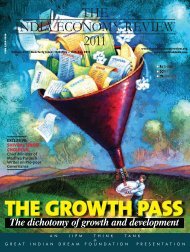Download - The India Economy Review
Download - The India Economy Review
Download - The India Economy Review
Create successful ePaper yourself
Turn your PDF publications into a flip-book with our unique Google optimized e-Paper software.
Plan and Policies:<br />
Unsolved Riddle<br />
Planning even in much smaller role today is important to<br />
address concerns of average <strong>India</strong>n but it certainly calls for a<br />
reorientation and repositioning of the goals and objective and<br />
need to rethink the mode of devolution of funds<br />
Ajitava Raychaudhuri<br />
Professor, Department of Economics,<br />
Jadavpur University,<br />
Kolkata<br />
<strong>India</strong>n planning is an exercise<br />
which was known for its enormity<br />
and fanfare next only to planning<br />
in the erstwhile socialist coun-<br />
tries. In its early days, Planning Commission<br />
invited noted scholars from around<br />
the world to streamline <strong>India</strong>n planning<br />
exercise. <strong>The</strong>y included such well known<br />
economists like Oscar Lange, Ragnar<br />
Frisch, Nicolas Kaldor, Alan Manne, to<br />
name a few. Perhaps this was due to the<br />
charisma of Prasanta Chandra Mahalanobis<br />
who directed planning in the early<br />
years and specially remembered for the<br />
second fi ve year plan model. Nobody<br />
could deny the importance of planning in<br />
<strong>India</strong>’s socio-economic development in<br />
the years following the independence in<br />
1947. <strong>The</strong> economy, which was a mixture<br />
of public sector and private sector from<br />
the very beginning, needed development<br />
in all spheres for economic growth. <strong>The</strong><br />
tilt towards heavy industries, which<br />
started from the second fi ve year plan,<br />
had mixed blessings for the economy. <strong>The</strong><br />
infrastructure (or core) industries like<br />
steel, coal and power, all developed under<br />
almost absolute control of the state. This<br />
certainly provided a good basis in the sixties<br />
and seventies for the development of<br />
other sectors like Railways, Heavy Machinery,<br />
Machine tools etc. At the same<br />
time such a strategy appeared to be heading<br />
for a time inconsistency problem since<br />
the late seventies and early eighties, with<br />
the fi rm but unholy grip of license-permit<br />
Raj in the economy.<br />
What exactly do we mean by the time<br />
inconsistency problem here? In the fi rst<br />
few years after independence, rightly or<br />
D EVELOPMENTAL PLANNING<br />
wrongly, the planners looked more towards<br />
the socialist patterns of comprehensive<br />
planning instead of indicative<br />
planning of French variety. <strong>The</strong> production<br />
of coal and steel under the state sector<br />
might have produced mafi as who extracted<br />
rent out of the system, but this<br />
system coupled with the freight equalization<br />
policy provided the much needed<br />
core sector products at a distorted but<br />
cheap price even to the private sector. In<br />
fact, whatever major infrastructural development<br />
we had in the Railways, Roads,<br />
Ports and Major Irrigation in the last<br />
century, the lion’s share belonged to the<br />
fi rst thirty years of planning which started<br />
in 1951. From the mid-eighties, it was increasingly<br />
realized that the so-called vision<br />
of self-suffi ciency created more dependence<br />
on foreigners in some crucial<br />
THE INDIA ECONOMY REVIEW<br />
125





